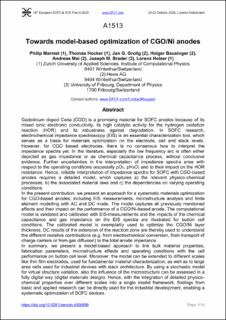Bitte benutzen Sie diese Kennung, um auf die Ressource zu verweisen:
https://doi.org/10.21256/zhaw-26054Langanzeige der Metadaten
| DC Element | Wert | Sprache |
|---|---|---|
| dc.contributor.author | Marmet, Philip | - |
| dc.contributor.author | Hocker, Thomas | - |
| dc.contributor.author | Grolig, Jan G. | - |
| dc.contributor.author | Bausinger, Holger | - |
| dc.contributor.author | Mai, Andreas | - |
| dc.contributor.author | Brader, Joseph M. | - |
| dc.contributor.author | Holzer, Lorenz | - |
| dc.date.accessioned | 2022-11-11T14:47:29Z | - |
| dc.date.available | 2022-11-11T14:47:29Z | - |
| dc.date.issued | 2020-10-20 | - |
| dc.identifier.uri | https://digitalcollection.zhaw.ch/handle/11475/26054 | - |
| dc.description.abstract | Gadolinium doped Ceria (CGO) is a promising material for SOFC anodes because of its mixed ionic electronic conductivity, its high catalytic activity for the hydrogen oxidation reaction (HOR) and its robustness against degradation. In SOFC research, electrochemical impedance spectroscopy (EIS) is an essential characterization tool, which serves as a basis for materials optimization on the electrode, cell and stack levels. However, for CGO based electrodes, there is no consensus how to interpret the impedance spectra yet. In the literature, especially the low frequency arc is often either depicted as gas impedance or as chemical capacitance process, without conclusive evidence. Further uncertainties in the interpretation of impedance spectra arise with respect to the operating conditions (especially pO2, pH2O) and to their impact on the HOR resistance. Hence, reliable interpretation of impedance spectra for SOFC with CGO-based anodes requires a detailed model, which captures a) the relevant physico-chemical processes, b) the associated material laws and c) the dependencies on varying operating conditions. In the present contribution, we present an approach for a systematic materials optimization for CGO-based anodes, including EIS measurements, microstructure analysis and finite element modelling with AC and DC mode. The model captures all previously mentioned effects and their impact on the performance of a CGO/Ni-based anode. The computational model is validated and calibrated with EIS-measurements and the impacts of the chemical capacitance and gas impedance on the EIS spectra are illustrated for button cell conditions. The calibrated model is exemplarily used to optimize the CGO/Ni layer thickness. DC results of the extension of the reaction zone are thereby used to understand the different resistive contributions (e.g. from electrochemical conversion, from transport of charge carriers or from gas diffusion) to the total anode impedance. In summary, we present a model-based approach to link bulk material properties, fabrication parameters, microstructure effects and operating conditions with the cell performance on button cell level. Moreover, the model can be extended to different scales like thin film electrodes, used for fundamental material characterization, as well as to large area cells used for industrial devices with stack architecture. By using a stochastic model for virtual structure variation, also the influence of the microstructure can be assessed in a fully digital way (digital materials design). Hence, with the integration of detailed physicochemical properties over different scales into a single model framework, findings from basic and applied research can be directly used for the industrial development, enabling a systematic optimization of SOFC devices. | de_CH |
| dc.language.iso | en | de_CH |
| dc.publisher | Zenodo | de_CH |
| dc.rights | https://creativecommons.org/licenses/by/4.0/ | de_CH |
| dc.subject | EFCF2020 | de_CH |
| dc.subject | SOFC | de_CH |
| dc.subject | Electrochemical impedance spectroscopy | de_CH |
| dc.subject | Multiphysics FEM simulation | de_CH |
| dc.subject.ddc | 621.3: Elektro-, Kommunikations-, Steuerungs- und Regelungstechnik | de_CH |
| dc.title | Towards model-based optimization of CGO/Ni anodes | de_CH |
| dc.type | Konferenz: Paper | de_CH |
| dcterms.type | Text | de_CH |
| zhaw.departement | School of Engineering | de_CH |
| zhaw.organisationalunit | Institute of Computational Physics (ICP) | de_CH |
| dc.identifier.doi | 10.5281/zenodo.4556898 | de_CH |
| dc.identifier.doi | 10.21256/zhaw-26054 | - |
| zhaw.conference.details | 14th European SOFC & SOE Forum, Lucerne, Switzerland (online), 20-23 October 2020 | de_CH |
| zhaw.funding.eu | No | de_CH |
| zhaw.originated.zhaw | Yes | de_CH |
| zhaw.publication.status | publishedVersion | de_CH |
| zhaw.publication.review | Peer review (Abstract) | de_CH |
| zhaw.webfeed | Multiphysics Modeling | de_CH |
| zhaw.funding.zhaw | Versatile oxide fuel cell microstructures employing WGS active titanate anode current collectors compatible to ferritic stainless steel interconnects (VOLTA) | de_CH |
| zhaw.author.additional | No | de_CH |
| zhaw.display.portrait | Yes | de_CH |
| Enthalten in den Sammlungen: | Publikationen School of Engineering | |
Dateien zu dieser Ressource:
| Datei | Beschreibung | Größe | Format | |
|---|---|---|---|---|
| 2020_Marmet_CGO-Ni-anode-model-based-optimization_EFCF.pdf | 1.48 MB | Adobe PDF |  Öffnen/Anzeigen |
Zur Kurzanzeige
Marmet, P., Hocker, T., Grolig, J. G., Bausinger, H., Mai, A., Brader, J. M., & Holzer, L. (2020, October 20). Towards model-based optimization of CGO/Ni anodes. 14th European SOFC & SOE Forum, Lucerne, Switzerland (Online), 20-23 October 2020. https://doi.org/10.5281/zenodo.4556898
Marmet, P. et al. (2020) ‘Towards model-based optimization of CGO/Ni anodes’, in 14th European SOFC & SOE Forum, Lucerne, Switzerland (online), 20-23 October 2020. Zenodo. Available at: https://doi.org/10.5281/zenodo.4556898.
P. Marmet et al., “Towards model-based optimization of CGO/Ni anodes,” in 14th European SOFC & SOE Forum, Lucerne, Switzerland (online), 20-23 October 2020, Oct. 2020. doi: 10.5281/zenodo.4556898.
MARMET, Philip, Thomas HOCKER, Jan G. GROLIG, Holger BAUSINGER, Andreas MAI, Joseph M. BRADER und Lorenz HOLZER, 2020. Towards model-based optimization of CGO/Ni anodes. In: 14th European SOFC & SOE Forum, Lucerne, Switzerland (online), 20-23 October 2020. Conference paper. Zenodo. 20 Oktober 2020
Marmet, Philip, Thomas Hocker, Jan G. Grolig, Holger Bausinger, Andreas Mai, Joseph M. Brader, and Lorenz Holzer. 2020. “Towards Model-Based Optimization of CGO/Ni Anodes.” Conference paper. In 14th European SOFC & SOE Forum, Lucerne, Switzerland (Online), 20-23 October 2020. Zenodo. https://doi.org/10.5281/zenodo.4556898.
Marmet, Philip, et al. “Towards Model-Based Optimization of CGO/Ni Anodes.” 14th European SOFC & SOE Forum, Lucerne, Switzerland (Online), 20-23 October 2020, Zenodo, 2020, https://doi.org/10.5281/zenodo.4556898.
Alle Ressourcen in diesem Repository sind urheberrechtlich geschützt, soweit nicht anderweitig angezeigt.